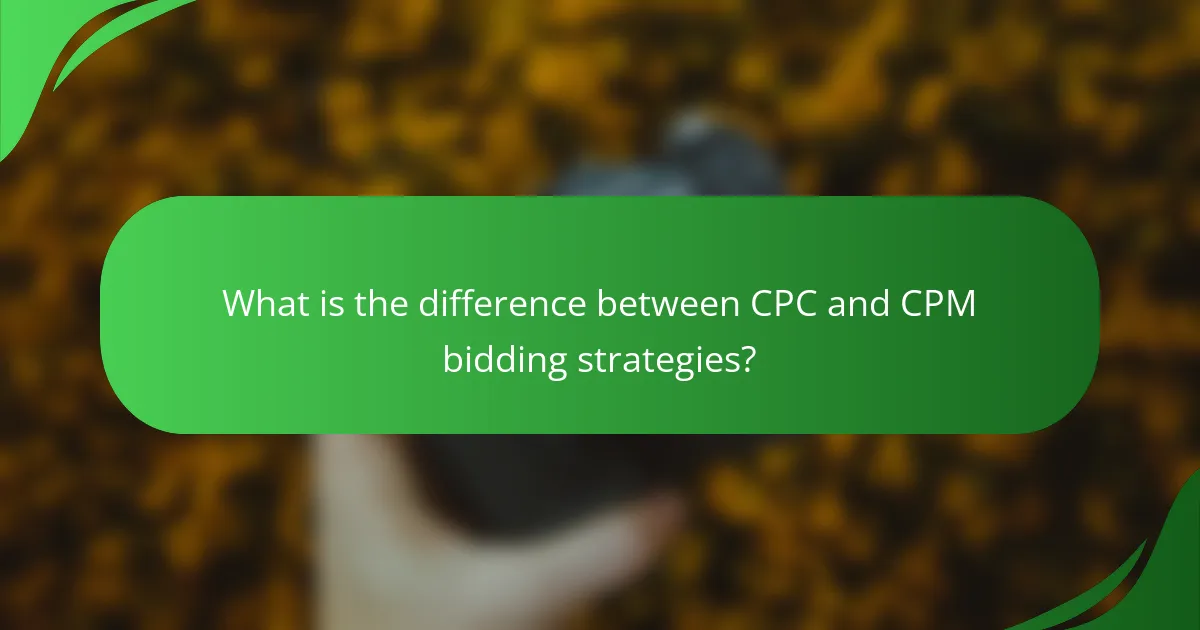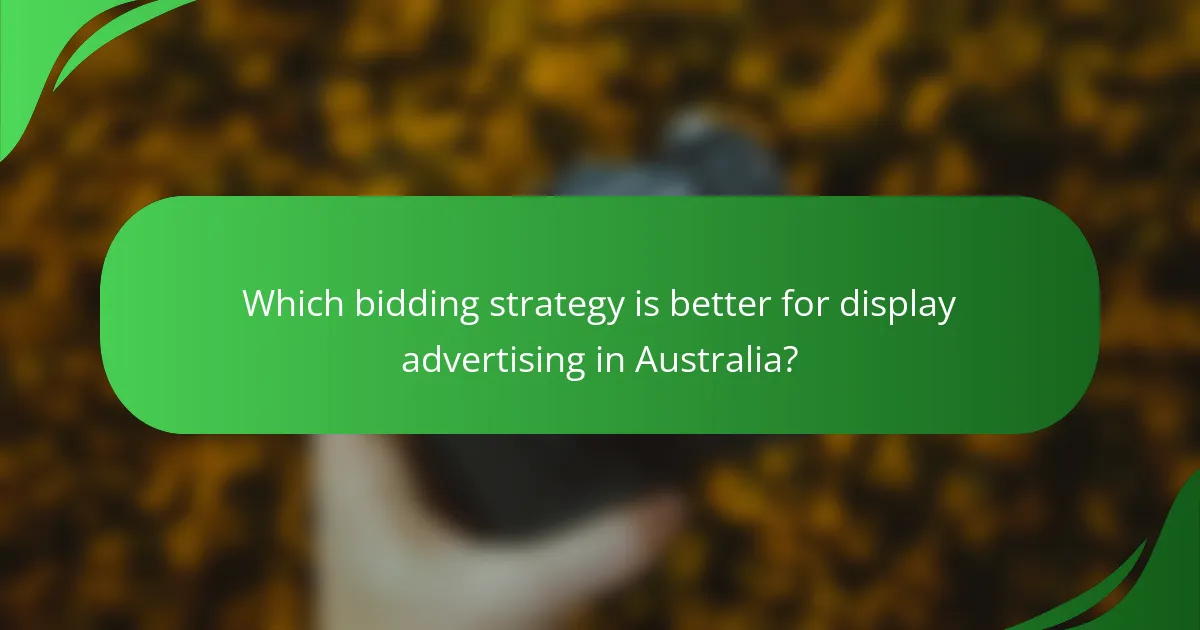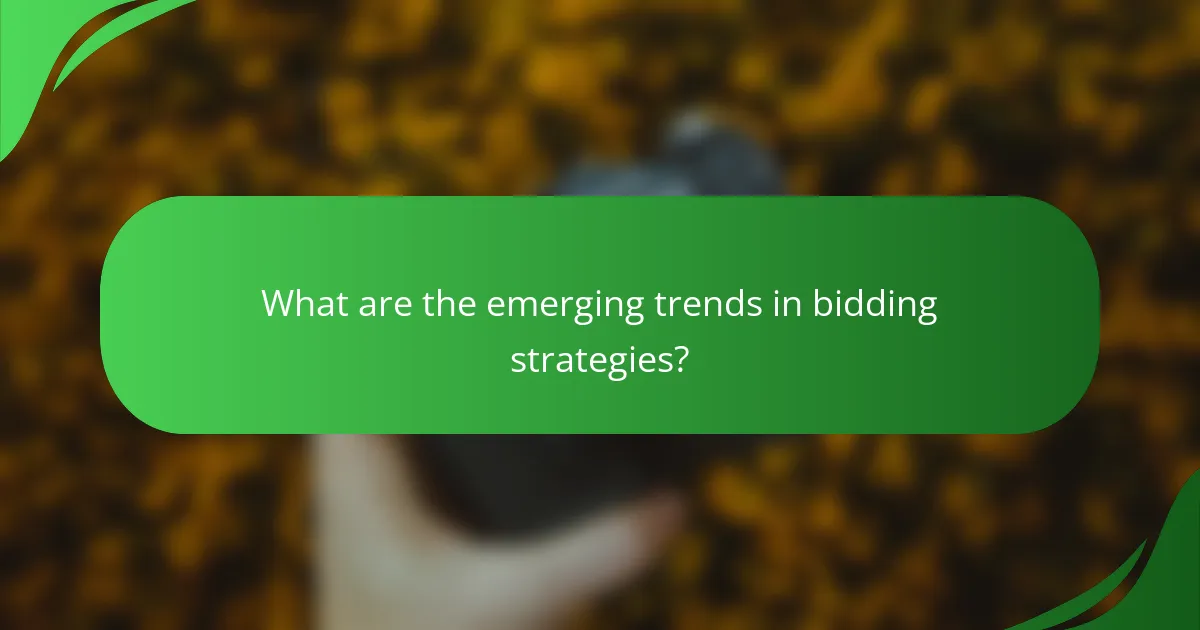When it comes to online advertising, understanding the difference between CPC (Cost Per Click) and CPM (Cost Per Mille) is crucial for optimizing your campaigns. CPC charges advertisers for each click on their ads, making it ideal for driving traffic and conversions, while CPM focuses on impressions, making it better suited for brand awareness and visibility. Your choice between these strategies should align with your specific advertising goals and desired engagement outcomes.

What is the difference between CPC and CPM bidding strategies?
CPC (Cost Per Click) and CPM (Cost Per Mille) are two distinct bidding strategies used in online advertising. CPC focuses on paying for each click on an ad, while CPM charges advertisers for every thousand impressions, regardless of clicks.
CPC (Cost Per Click) definition
CPC, or Cost Per Click, is a bidding model where advertisers pay a fee each time a user clicks on their ad. This strategy is particularly effective for campaigns aimed at driving traffic to a website or generating leads, as advertisers only incur costs when users engage with their ads.
For example, if an advertiser sets a CPC bid of $1 and receives 100 clicks, they will pay $100. This model encourages advertisers to optimize their ads for higher click-through rates to maximize their return on investment.
CPM (Cost Per Mille) definition
CPM, or Cost Per Mille, refers to the cost of acquiring 1,000 impressions of an ad. Advertisers using this model pay for ad visibility rather than user interaction, making it suitable for brand awareness campaigns where the goal is to reach a large audience.
For instance, if an advertiser sets a CPM rate of $5, they will pay $5 for every 1,000 times their ad is displayed. This approach is beneficial for campaigns focused on building brand recognition rather than immediate clicks.
Key differences between CPC and CPM
The primary difference between CPC and CPM lies in how advertisers are charged. CPC is performance-based, charging only for clicks, while CPM is impression-based, charging for visibility. This distinction influences campaign objectives: CPC is ideal for direct response campaigns, whereas CPM suits brand awareness initiatives.
Another key difference is the level of control over spending. With CPC, advertisers can set maximum bids for clicks, allowing for tighter budget management. In contrast, CPM requires advertisers to estimate the reach and impressions needed, which can lead to variable costs depending on ad performance.
When choosing between CPC and CPM, consider your campaign goals. If you want to drive traffic and conversions, CPC is likely the better option. However, if your focus is on maximizing exposure and brand visibility, CPM may be more effective.

Which bidding strategy is better for display advertising in Australia?
In Australia, the choice between CPC (Cost Per Click) and CPM (Cost Per Mille) depends on your advertising goals. CPC is typically better for driving traffic and conversions, while CPM is more suited for brand awareness and visibility.
Advantages of CPC for display ads
CPC allows advertisers to pay only when a user clicks on their ad, making it a cost-effective option for campaigns focused on generating traffic. This strategy is particularly beneficial for businesses looking to optimize their return on investment (ROI) by targeting specific audiences more effectively.
With CPC, advertisers can set maximum bids for clicks, enabling better budget control. For example, if your goal is to achieve a certain number of leads, you can adjust your bids based on performance metrics to maximize conversions.
Advantages of CPM for display ads
CPM is advantageous for campaigns aimed at increasing brand visibility, as it charges advertisers based on impressions rather than clicks. This approach is ideal for businesses wanting to reach a larger audience quickly, as it often results in lower costs per impression compared to CPC.
Using CPM can also simplify budget management, as you can predict costs based on the number of impressions you wish to achieve. For instance, if you plan to run a campaign that targets thousands of views, CPM allows you to allocate your budget accordingly while focusing on brand exposure.

How to choose between CPC and CPM for your campaign?
Choosing between CPC (Cost Per Click) and CPM (Cost Per Mille) depends on your campaign goals and the type of engagement you seek. CPC is ideal for driving traffic and conversions, while CPM is suited for brand awareness and visibility.
Factors to consider when choosing
When selecting between CPC and CPM, consider your campaign objectives, budget, and target audience. If your goal is to generate leads or sales, CPC may provide better value as you only pay for actual clicks. Conversely, if your focus is on reaching a wide audience, CPM can be more cost-effective.
Evaluate your historical data and performance metrics. If previous campaigns show a high click-through rate (CTR) and conversion rate, CPC could be advantageous. However, if impressions are more critical, CPM might be the better option.
Target audience impact on bidding strategy
Your target audience significantly influences your bidding strategy. For niche markets with high conversion potential, CPC can maximize your return on investment by targeting specific users who are more likely to engage. In contrast, for broader audiences, CPM can enhance brand visibility across a larger demographic.
Consider the platforms you are using as well. Some social media channels and display networks may perform better with one strategy over the other based on audience behavior. Testing both strategies with a small budget can help determine which approach resonates more effectively with your audience.

What are the common use cases for CPC and CPM?
CPC (Cost Per Click) and CPM (Cost Per Mille) are two popular bidding strategies used in online advertising, each suited for different objectives. CPC is ideal for campaigns focused on driving traffic and conversions, while CPM is better for brand awareness and visibility.
Best use cases for CPC
CPC is most effective when the goal is to generate immediate traffic to a website or landing page. Advertisers pay only when a user clicks on their ad, making it a cost-efficient option for campaigns aimed at driving specific actions, such as sign-ups or purchases.
For instance, e-commerce businesses often utilize CPC to promote limited-time offers or new products, as they can closely track the return on investment (ROI) based on actual clicks leading to sales. Setting a reasonable bid range, such as $0.50 to $2.00 per click, can help optimize spending while maximizing reach.
Best use cases for CPM
CPM is best suited for campaigns focused on brand exposure rather than direct conversions. Advertisers pay for every thousand impressions, making it ideal for building brand awareness and reaching a larger audience without the need for immediate action.
For example, companies launching new products or entering new markets may choose CPM to ensure their ads are seen by a wide audience. A typical CPM range might be between $5 to $20, depending on the platform and target demographics, allowing advertisers to balance visibility with budget constraints.

What tools can help manage CPC and CPM campaigns?
Several tools can effectively manage CPC and CPM campaigns, helping advertisers optimize their spending and maximize returns. Key platforms like Google Ads and Facebook Ads provide robust features tailored to each bidding strategy, allowing for precise targeting and performance tracking.
Google Ads for CPC management
Google Ads is a leading platform for managing CPC campaigns, allowing advertisers to bid on keywords that trigger their ads. With features like keyword planner and ad previews, users can identify high-performing keywords and adjust bids accordingly to improve visibility and click-through rates.
To optimize CPC, consider setting a daily budget that aligns with your overall marketing goals. Monitor your Quality Score, as higher scores can lower your CPC, making your ads more cost-effective. Regularly review performance metrics to refine your strategy and focus on keywords that yield the best results.
Facebook Ads for CPM management
Facebook Ads excels in managing CPM campaigns, enabling advertisers to pay for ad impressions rather than clicks. This approach is particularly effective for brand awareness and reaching a larger audience. Advertisers can target specific demographics, interests, and behaviors to ensure their ads are seen by the right people.
When using Facebook Ads for CPM, set clear objectives for your campaign, such as increasing brand visibility or engagement. Monitor the frequency of your ads to avoid ad fatigue, which can diminish effectiveness. Utilize A/B testing to compare different ad creatives and optimize your CPM strategy based on performance data.

What are the emerging trends in bidding strategies?
Emerging trends in bidding strategies focus on increased automation and data-driven decision-making. Advertisers are increasingly adopting advanced techniques that leverage real-time data to optimize their campaigns effectively.
Programmatic advertising advancements
Programmatic advertising is revolutionizing how bids are placed by automating the buying process. This technology allows advertisers to purchase ad space in real-time, making it possible to adjust bids based on performance metrics and audience behavior.
With programmatic advertising, advertisers can target specific demographics and interests, which enhances the efficiency of ad spend. For example, using platforms like Google Ads or Facebook Ads, marketers can set parameters that automatically adjust bids based on the likelihood of conversion.
Impact of AI on bidding strategies
Artificial intelligence (AI) is significantly influencing bidding strategies by enabling more sophisticated algorithms that predict outcomes based on historical data. AI can analyze vast amounts of data quickly, allowing for real-time adjustments to bids that enhance campaign performance.
For instance, AI-driven tools can identify optimal bidding times and adjust budgets accordingly, maximizing return on investment. Advertisers should consider integrating AI solutions to stay competitive, as these technologies can lead to improved targeting and reduced costs over time.



